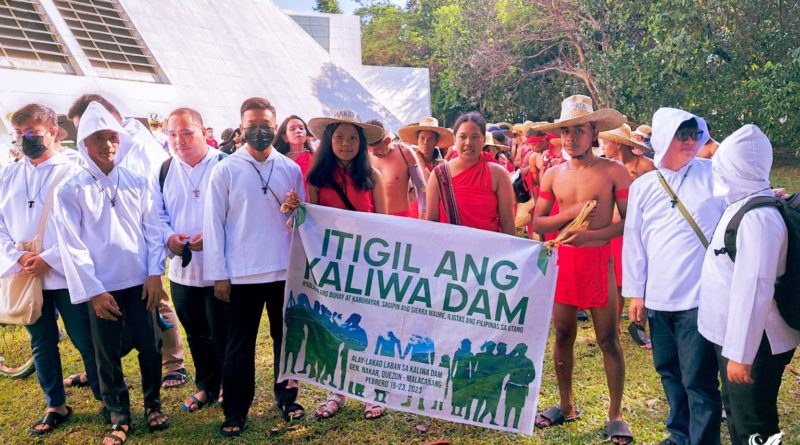HEADLINE-ECONOMY | China-Funded Dam Threatens Philippine’s Indigenous People
.
.
“We are not against progress. Progress is something all of us want for ourselves, for our families and communities; but not everything that gets built – buildings, bridges, and, yes, dams—can be said to bring progress when they destroy the natural environment. It’s not progress if it means driving indigenous people away from their ancestral lands,” said Marcelino Tena, 60 years old, a member of the Dumagat-Remontados, a tribe of indigenous Filipinos who have lived in the Southern Tagalog region of the Philippines long before the Philippines was first “discovered” and then colonized by Spain in the year 1521.
The Dumagat-Remontados are a subgroup of the Dumagat people. Remontados means “those who went up” in Spanish, and it refers to the Dumagat people who fled to the mountains to escape Spanish colonial rule during the 16th century. The Remontados have managed to preserve their traditional way of life, which involves subsistence farming, hunting, and gathering.
Tatay Lino, a leader of the Dumagat-Remontados, has for the last six years been at the forefront of the campaign against the construction of the Kaliwa Dam project, which threatens the way of life, environment and biodiversity.

Sierra Madre in danger
Also known as the New Centennial Water Source Project, the Kaliwa Dam project is a proposed dam and water supply system in the Sierra Madre mountain range. It aims to supply 600 million liters of water per day for 17.46 million people or about 3.49 million households in Metro Manila, Rizal and Quezon. The Kaliwa Dam will supposedly reduce the current 97 percent dependence on the Angat Dam.
Dams have already been proven problematic in the long run by environmentalists, but the Kaliwa Dam is causing extreme alarm because of its location.
The Sierra Madre is a crucial biodiversity hotspot and it is estimated that around 70 percent of the Philippines’ plant and animal species, around 126 species, can be found there, including many endemic species found nowhere else in the world.
The Sierra Madre is also an important watershed as it provides water to many rivers and streams in the region. These rivers and streams are essential for agriculture, fishing and other industries that are critical to the Philippine economy.
Finally, the mountain range also plays an important role in regulating the climate as it moderates temperatures and absorbs carbon dioxide as an important carbon sink.
For all these reasons, the Kaliwa Dam that will pass through the mountain range is strongly opposed by many environmental groups and civic organizations that raise concerns about the dam’s potential impact on the environment, local communities, and indigenous peoples.
“The mountain range is our home, and it is the home of many endangered species such as the Philippine eagle, the tamaraw, and the Mindoro dwarf buffalo. If the dam is built along with the other infrastructure connected to it, they will destroy the natural habitat of all these animals,” said Tatay Lino.
Importantly too, is the very real threat of displacement of local communities and indigenous peoples.
“This dam will bring so much destruction. We will lose our ancestral lands, and our traditional practices like hunting and gathering will be disrupted,” he said.
Tatay Lino said these traditions, and the access to their ancestral lands where they have buried their dead for centuries, are essential to the Dumagat and the Agtas’ cultural and economic survival.
“The dam construction site falls within our ancestral domain and there are over 5,000 families of Dumagat-Remontados living there. Already 300 of these families are directly affected since the construction began in September last year. Thousands more of us will be forced to evacuate eventually,” he said.
The seriousness of the situation has forced the Dumagat-Remontados to embark on a nine-day journey on foot from their homes in the mountains to Manila, the country’s capital. Wearing their traditional garb and bearing placards calling for a stop to the dam construction, 300 of them walked 150 kilometers all to way to the presidential palace in Malacanang, hoping to get an audience with President Ferdinand Marcos Jr.
However, officials did not allow them into the palace grounds. The Dumagat-Remontados also went to the headquarters of the Metropolitan Waterworks and Sewerage System (MWSS) but they were turned away by security guards at the closed gates.
“President Marcos did not even send a representative to see us, but we do not see our action as a failure. Thousands of Filipinos especially those in Manila saw us take to the streets, appealing to save the Sierra Madre and to stop the dam,” Tatay Lino said.
The event was well-reported by the local media as well as the international press, and Tatay Lino was among those who were most interviewed. They were joined by contingents from organizations of church people, environmentalists, students and teachers, farmers, workers, and the urban poor.

Coming to blows
Tatay Lino explained to Maritime Fairtrade that up to the present, the project has failed to secure Free Prior and Informed Consent (FPIC) from them. Allegations are rife that the main project proponent, the MWSS, is colluding with the National Commission on Indigenous Peoples (NCIP) and some local officials, to manipulate and railroad the legal processes to allow the dam project to proceed.
“It’s clear that government agencies are ignoring what is stated in the very laws that should supposedly protect us. They said that the Indigenous Peoples’ Rights Act (IPRA) upholds the indigenous communities’ right to a Free, Prior, and Informed Consent process, but they are twisting the process, making arbitrary exceptions to it left and right,” he said.
According to him, the MWSS and NCIP have done many consultations with the Indigenous Peoples, in local resorts and hotels, but they failed to secure the consent of the majority. To circumvent the law, he alleged, the agencies “manipulated the process and locked out the majority of us from meetings.”
“They took a handful of our leaders, cajoled and pressured them into signing some blanket agreement, and said that all of us have given the project our approval,” he said. “We were not even allowed to take photos or videos of the proceedings. At some point, chaos broke out and people almost came to blows,” he said.
Bribery allegations
In acknowledgment of the social and environmental costs of the project, the MWSS released P160 million (US$2,943,424) in disturbance fees to two indigenous people groups, which Tatay Lino said was an underhanded move.
“We also heard that the MWSS gave these so-called groups P80 million (US$1,471,548) for community development programs, and it was nothing but a bribe. We do not recognize these so-called indigenous people groups and we certainly did not take a single peso of the P80 million bribe,” he said.
Another tragedy that has happened directly related to the dam project is how the issue has divided and even broke family and friendship ties among the Dumagat-Remontados.
“We have always lived together in harmony, all of us. We are like a majestic tree with many, many branches. This issue of the dam has sown discord among us, and now we have entire families refusing to speak to some of their members. Most of the Dumagat-Remontados are against the dam, but there are those of us who have been tricked into believing the empty lies and promises of the NCIP and the MWSS. There is nothing these agencies and government can offer us that will justify losing our way of life and home in the Sierra Madre,” he said sadly.

Options for Metro Manila water shortage problem
Other opponents of the Kaliwa Dam project also pointed out there are alternative means to address the water shortage problem in Manila, such as improved water conservation measures and investment in alternative sources of water, such as desalination and rainwater harvesting.
The Kalikasan People’s Network for the Environment (KPNE) and the Center for Environmental Concerns (CEC) alongside other environmental groups denounced the dam project as illegal, and destructive to the environment. They also said it violates the Philippine constitution and overall national interest.
“Never for a moment do we believe that the dam is necessary just to meet the water supply needs of Metro Manila. We believe that the supposed water crisis is only being used to expedite and justify the Kaliwa Dam Project as the most viable “solution” despite other existing alternatives,” the groups said.
Maritime Fairtrade found that the dam will cause long-term, irreversible environmental damage to the Sierra Madre and its biodiversity. The project, which many believed is illegal, is within the Kaliwa Watershed, a designated forest reserve, national park and wildlife sanctuary. Building a dam violates the National Integrated Protected Areas System (NIPAS) Act, and the Expanded NIPAS Act.
Tatay Lino said their groups have been having a hard time securing copies of the Environmental Compliance Certificate (ECC) from the Department of Environment and Natural Resources (DENR).
“We cannot understand how they will be able to even begin to meet the requirement of minimizing the environmental impact of the dam. We have consulted with experts who warn that in the areas surrounding the dam site, 100,000 individual lives will be put at risk with increased chances of heavy flooding, especially in the downstream areas,” he said.
The dam structure, with a spillway, diversion tunnels, a low-level outlet, and a reservoir, will affect communities in the municipalities of Nakar and Infanta, both in Quezon. The plans are for a 60-meter-high structure, which will contain an initial 600 million liters of water per day.
As of this writing, digging for the tunnels has already begun. Each will be 4 meters in diameter and 27.70 kilometers in length. The depth from the lowest peak is 70 meters while the depth from the highest peak is 500 meters. The project is planned to have a storage capacity of 57 cubic meters and covers 113 hectares of the forests of the Sierra Madre.

China loans are funding the dam project
Progressive lawmakers have also thrown their lot with the anti-dam protestors, pointing out that the project is “politically tainted”.
As early as 2018, Bayan Muna (People First) Representative Karlos Zarate said the Kaliwa dam involved a loan from China whose terms are onerous and unnecessary.
Zarate said: “Who’s going to pay off these loans? It will be the Filipino people. The signed loan agreement states that the project will require a loan of at least 12 billion (US$220,703,029) that runs on a high yearly interest of two percent. There will also be upfront spending of at least P2 billion (US$36,783,838) from the national treasury.
“Projects such as these are not economically viable and from all sides, it proves to be disadvantageous for taxpayers, not counting all the environmental and social repercussions. If we fail to pay within China’s terms, the Philippine government has to surrender the country’s assets and resources as payment, specifically including waiving the Philippines’ rights to sovereignty. It’s completely outrageous.”
The Kaliwa dam is one of the previous Duterte government’s banner projects under the Build, Build, Build (BBB) program. When it was first announced, it was touted as a focus of the Philippines’ participation in China’s “Belt and Road Initiative” (BRI) and part of the Duterte administration’s close relationship with China.
The dam is being funded from a combination of a loan agreement under an official development assistance (ODA) loan from China and funds from the Philippine government’s regular budget. Official statements revealed that 85 percent of the project cost, or about P12.2 billion, will be financed by the Export-Import Bank of China (EXIM) under the Preferential Buyer’s Credit Loan Agreement. The project contractor is China Energy Engineering Corporation (CEEC). The project’s implementing agency is the MWSS.
Human rights lawyer Neri Colmenares pointed out the Chinese loan put Philippine’s sovereignty at serious risk and compromises the country’s constitutional rights.
“We should never implement so-called development projects that will put human rights, our environment, Philippine laws, and sovereignty at risk. We cannot sacrifice the rights, welfare, and very future of our indigenous people brothers and sisters,” he said.

Resistance from government units
Opposition against the dam is also firm among the ranks of many local officials, among them the leadership team of the local government of Infanta.
In an interview with Maritime Fairtrade, Mayor Filipina Grace R. America of Infanta said the elected community leaders are all against the dam project.
“None of us in good conscience can support such a project that has such severe implications on our environment and our people. From the very beginning we have made it known to the national government we cannot make compromises on this issue because we know full well how the dam will damage Infanta and our neighbor municipalities,” she said.
…
The mayor admitted she found it questionable how the dam continues to be constructed despite the refusal of Infanta to give consent. Her office has submitted official position papers on the dam project. By law, local governments have to provide their official endorsement to national government projects.
“Construction continued even during the height of the COVID-19 pandemic,” she said. “We do not question the authority of the national government and the desire to promote progress and water security for our country, but we must also say we are duty-bound to uphold the general welfare of our local people whom we are certain will suffer because of the dam,” she said.
The mayor has also submitted a series of recommendations to the national government on what needs to be implemented before the dam project should proceed. Among these are the establishment of resettlement and relocation sites for all affected citizens; the immediate allocation of P3 billion (US$ 54,927,450) for the complete construction of an Agos River Flood Control and Drainage Project; and the enforcement of all environmental laws such as the National Protected Areas System (NIPAS).
“In truth, our stand is there really can be no justifying the dam project and there can be no mitigating what stands to be lost if it is built. The Department of Interior and Local Government (DILG) asked us to put together recommendations and we submitted them. We said all these recommendations should first be implemented before any construction for the dam can begin, but the dam is being built already anyway,” she said.
The mayor has stood her ground against the dam project even with threats to her life. On February 27, 2022, three months before the local and national elections, she was shot by unknown assailants as she was entering her car after attending mass. Seven spent bullet casings were found at the scene, and she had to be airlifted to Manila for medical treatment. She has since been left paralyzed from the waist down but she vowed to continue to perform her duties after being reelected in May 2022.
While investigations have not found any links between the attack and the mayor’s stance, observers said it is likely she was shot because she opposed to the dam construction.
Negative impact on Infanta
The land area of the municipality of Infanta is a delta territory with low elevation and is connected to the towns of Real and General Nakar. During the rainy season, the Agos River overflows and often floods the barangays or communities within its periphery, including Infanta.
Infanta does not have any dikes or sewage systems that can protect it from floodwaters and typhoons. If the dam overflows, the repercussions for the town will be severe.
Part of the active Philippine Fault Zone which passes through communities in General Nakar, Infanta, and Real municipalities in Quezon province is only 16.54 kilometers from where the dam is being built. The dam is southeast of the fault zone, and a strong earthquake is certain to cause damage to the dam.
Based on the research of the PhilVolcs (DEFINE), on July 18, 1880, Infanta experienced a 7.6 magnitude earthquake that completely leveled a concrete Franciscan church. Should another earthquake of similar or greater magnitude takes place, there are no guarantees that the dam will not suffer the same fate.
Experts have said if the dam collapses, it will flood Infanta and the surrounding towns and communities, causing immense damage to the communities.
Infanta is also threatened by a loss of drinking water as well as water for agricultural, commercial, and industrial needs. This is because the dam will act as a barrier stopping the flow of the Agos River.
“The dam hasn’t even been built yet, but our water supplies become limited during the dry season,” a local Infanta resident said.
Mayor America also pointed out the dam will harm rice production. This, she said, will affect 1,859 farmers who rely on the irrigation system, which the dam will disrupt. The farmers cultivate 1,202.50 hectares of Infanta’s agricultural land annually, harvesting 10,625.30 metric tons of rice the farmers will sell for a total of P180,630,100 (US$3,322,546).
“We also have apprehensions that our fisheries sector will be impacted by the dam project,” she said.

Protests against dam construction
On March 14, 2023, human rights activists and defenders of the environment marked International Day of Action for Rivers, and one of the core messages of the campaign concerned the opposition against dams.
The Kalikasan People’s Network for the Environment (KPNE) said the Philippines has 421 rivers but many have already been damaged because of human activities, including the construction of large dams.
There are 15 existing and seven proposed large dams in the country, and the government justifies them as means to solve water and electricity demand problems. Dams, however, are a problem by themselves.
According to a KPNE’s statement: “Large dams have grave impacts on the environment and the people. These can alter water and sediment flow, and cause a decrease in the water quality of the river system. It can also cause river fragmentation that can change both the riparian and aquatic ecosystems affecting habitats, biodiversity, and other ecosystem services. It will affect not only plants and animals but also humans who are dependent on the watershed for their sustenance.”
The international Curitiba Declaration states that “dams force people from their homes, submerge fertile farmlands, forests, and sacred places, destroy fisheries and clean water supply, and cause social and cultural disintegration and economic impoverishment of our communities.”
Several mega dams are in the pipeline, but Filipinos living within the construction areas are actively campaigning against them, especially the communities of indigenous peoples. In Iloilo in the Visayas region, the Jalaur Mega Dam is opposed by the Tumandok indigenous group. The Tumandok did not give their free, prior, and informed consent (FPIC) for the dam construction, but the project still proceeded and will be completed by December of this year.
There is also the Ahunan Dam project in Pakil, Laguna, which, environmentalists and local leaders said will displace residents, erode their traditions and dry up local springs and pools. In June 2022, environmental defender Vertudez “Daisy” Macapanpan was illegally arrested on trumped-up charges because of her opposition to the project.
As of this writing, the Dumagat-Remantados of Infanta, Nakar, and Real Quezon continued to appeal to the Filipino public and the international community to join them in their fight against the construction of the Kaliwa Dam.
Tatay Lino said he cannot imagine a future where his grandchildren and their children after them will no longer be able to see the Sierra Madre the way he experienced it growing up.
“We do not deny the right of those living in Metro Manila to have water, we are not greedy and selfish about the resources of the Sierra Madre. We only ask this – is sacrificing our lives, our future, and the Sierra Madre itself worth it? Is there no other way?
“We will continue to oppose the Kaliwa Dam and do whatever it takes to stop the construction. We have everything to lose in struggle.”
Photos credit: Marcelino Tena and the Ateneo Matanglawin
https://maritimefairtrade.org/china-funded-dam-threatens-philippines-indigenous-people/









